Home > Digitized Walters Manuscripts
This document is a tranformation of a TEI P5 XML manuscript description incorporating images. If you have trouble reading special or non-Latin characters on this page, please make sure you have appropriate Unicode fonts installed and an up-to-date web browser.
Walters Ms. W.531, Trebizond Gospels
Browse images (Browse images in a new window) | TEI in XML format
W.531
Trebizond Gospels
This Gospel Book was probably made in Constantinople in the mid twelfth century and is remarkable for the fine execution and monumental quality of its full-page miniatures. The opening for the Gospel of Matthew is missing, but the other three Gospels are prefaced with a pair of miniatures each: the respective Evangelist on the left and a scene from the Gospel story on the right. The combination of St. John with the Raising of Lazarus is one found only in this manuscript. The text was copied by two scribes with distinctly different hands. One of them must have painted the ornament on fol. 175r, which contains curious animal figures.
Mid 12th century CE
Constantinople (Istanbul)
Book
Scriptural
The primary language in this manuscript is Greek, Ancient (to 1453).
Parchment
Medium quality, with some defects
Foliation: ii+233+ii
Three foliations: Pencil foliation from 1972 (followed here) in upper right corners of rectos, including 63bis; pencil foliation from 1935 in upper right corners of rectos, in parentheses; early twentieth-century pencil foliation in lower right corners of rectos
Formula: 1(10,-10), 2-9(8), 10(10,-3,7), 11-12(8), 13(6), 14-15(8), 16(4), 17(8), 18(10,-1,9), 19-22(8), 23(10,-8), 24(8,-1), 25-29(8), 30(6)
Catchwords: None
Signatures: Possibly original signatures in lower margin of first and last leaf, in magenta, occasionally visible (fols. 218v-219r); later signatures in brown ink in lower margins of first and last leaf of each quire, occasionally visible; later illegible signatures in lower margins, occasionally visible
Comments: Leaves rearranged in 1972, wrapped in modern stubs; two leaves foliated as 63; quire 23 has bifolium 173-174 inserted, stitched to fols. 176v-177r, fol. 175 is a singleton; quires begin on fols. 1(1), 10(2), 18(3), 26(4), 34(5), 42(6), 50(7), 58(8), 65(9), 73(10), 81(11), 89(12), 97(13), 103(14), 111(15), 119(16), 123(17), 131(18), 139(19), 147(20), 155(21), 163(22), 171(23), 180(24), 187(25), 195(26), 203(27), 211(28), 219(29), 227(30)
23.0 cm wide by 32.0 cm high
14.0 cm wide by 22.0 cm high
- Columns: 2
- Ruled lines: 23-25
- Hardpoint ruling
- Title: Gospel Book
- Contents: Fols. 1r-58v: Gospel of Matthew, beginning lost, starts with Matthew 5:12; fol. 59r: chapters list for the Gospel of Mark; fols. 61r-101r: Gospel of Mark; fol. 101v: chapters list for the Gospel of Luke; fols. 103r-172v, 176r-179v: Gospel of Luke; fol. 175r: chapters list for the Gospel of John; fols. 175r-v, 180r-232v: Gospel of John, end lost, ends with John 21:17
- Hand note: Copied by two hands: Hand A (fols. 1-101, 119, 122, 131, 171-172, 175-179, 211, 218), florid, widely-spaced minuscule in dark brown ink; Hand B (fols. 103-118, 120-121, 123-130, 132-170, 180-210, 212-217, 219-232), "epsylon"-style in black ink
- Decoration note: Six full-page miniatures (fols. 59v, 60r, 102v, 103r, 173v, 174r); two headpieces (fols. 61r, 175r); one illuminated initial (175r)
fol. 59v:
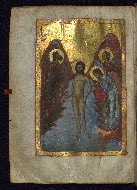
- Title: Baptism of Christ
- Form: Full-page miniature
- Comment:
Inscribed: "The Baptism."
The Holy Spirit is shown descending over Christ in the form of a dove. Two angels wait to receive him when he comes out of the water. The vaguely outlined figure on the lower left is a personification of the river Jordan.
fol. 60r:
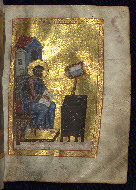
- Title: The Evangelist Mark
- Form: Full-page miniature
- Comment:
Inscribed: "Saint Mark."
The Evangelist holds an open book with the text of the beginning of his Gospel. In front of him is a writing desk, probably similar to the ones used by Byzantine scribes.
fol. 102v:
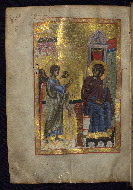
- Title: The Annunciation
- Form: Full-page miniature
- Comment:
Inscribed: "The Annunciation."
Just as in the image of the Baptism of Christ (fol. 59v), the Holy Spirit is shown here as a dove flying from above toward the Virgin (this detail of the miniature is very abraded, but it can be vaguely seen between the letters of the labeling inscription). Mary is in the process of spinning purple thread for the curtain of the Holy of Holies in the Temple of Jerusalem (Protoevangelium of James 10:2-11:1).
fol. 103r:
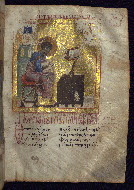
- Title: The Evangelist Luke
- Form: Half-page miniature
- Comment:
Inscribed: "The Holy Gospel According to Luke."
fol. 173v:
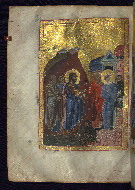
- Title: The Raising of Lazarus
- Form: Full-page miniature
- Comment:
Inscribed: "The Raising of Lazarus."
The Raising of Lazarus is not found as a frontispiece to a Gospel in any other manuscript. It is not clear why this particular scene was singled out for illustration. Notice how small Lazarus' sisters Martha and Mary are in comparison to Jesus. The man to the left of Lazarus is holding his nose, because the dead body has begun decomposing (John 11:17).
fol. 174r:
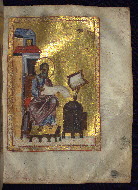
- Title: The Evangelist John
- Form: Full-page miniature
- Comment:
Inscribed: "Saint John the Theologian."
Unlike the other Evangelists, St. John is usually shown in Byzantine art as an elderly man. Notice also the oil lamp hanging above his writing desk.
fol. 175r:
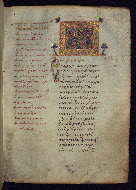
- Title: Title page of the Gospel of John
- Form: Ornamented headpiece, inhabited initial letter "E"
- Text: Table of contents for the Gospel of John, John 1:1-5
- Comment:
Inscribed: "Gospel According to John."
The initial letter "E" is decorated with two falcons, a partridge, and a hare. Falcons were specially trained to chase game and hunting was a favorite pastime of Byzantine noblemen (the sort of people who would commission a luxury manuscript like this one).
The binding is not original.
Light brown leather over squared wooden boards with blind and gold tooling; rebacked in 1972
Owned by Pellikidis, Trabzon, seen there by M. Alpatov in the autumn of 1924
Henry Walters, acquired before 1931, probably from Léon Gruel
Walters Art Museum, 1931, by Henry Walters' bequest
Clark, Kenneth. A Descriptive Catalogue of Greek New Testament Manuscripts in America. Chicago: University of Chicago Press, 1937, pp. 361-362.
Vikan, Gary, ed. Illuminated Greek Manuscripts from American Collections: An Exhibition in Honor of Kurt Weitzmann. Princeton, NJ: Princeton University Press, 1973, pp. 158-161, cat. no. 44.
Evans, Helen and William Wixom, eds. The Glory of Byzantium: Art and Culture of the Middle Byzantine Era, A.D. 843-1261. New York: Metropolitan Museum of Art, 1997, p. 97, cat. no. 51.
Parpulov, Georgi. “A Catalogue of Greek Manuscripts at the Walters Art Museum.” Journal of the Walters Art Museum 62 (2004): 71-189.
Principal cataloger: Parpulov, Georgi R.
Editors: Herbert, Lynley; Noel, William
Copy editor: Joyal, Stephanie
Conservators: Owen, Linda; Quandt, Abigail
Contributors: Bockrath, Diane; Emery, Doug; Noel, William; Tabritha, Ariel; Toth, Michael B.
The Walters Art Museum
Licensed for use under Creative Commons Attribution-NonCommercial-ShareAlike 3.0 Unported Access Rights, http://creativecommons.org/licenses/by-nc-sa/3.0/legalcode. It is requested that copies of any published articles based on the information in this data set be sent to the curator of manuscripts, The Walters Art Museum, 600 North Charles Street, Baltimore MD 21201.